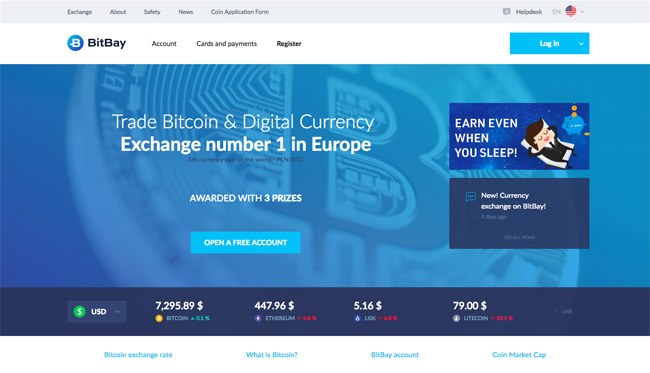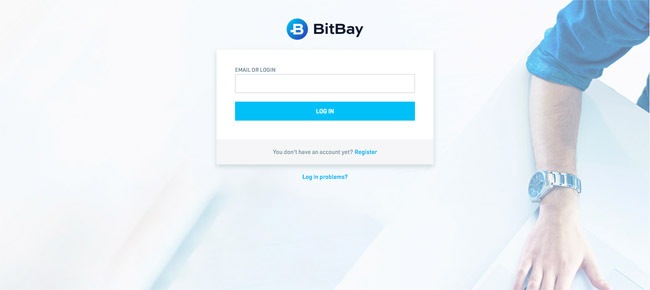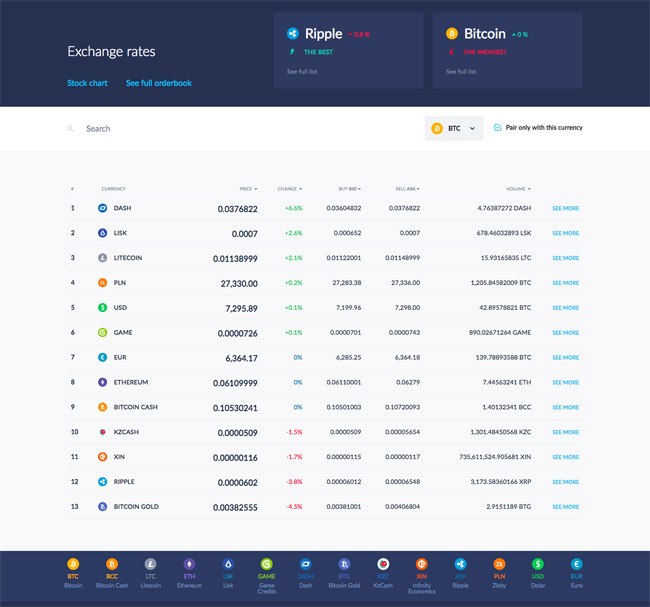BitBay is a cryptocurrency exchange that initiated its operations from the city of Katowice in Poland.
From its roots in Southern Poland to its new home in Malta, the exchange aims to power the local economy while serving a global audience in order to demonstrate the true meaning of a borderless business, especially when it operates in a medium which is built upon the same notion.
At the time of writing, the exchange trades in 11 cryptocurrencies and aims to provide its local and international customers with all the tools that they could need in order to perform cryptocurrency trading transactions that are easy to execute while also being accurate by market trends.
Since the exchange’s name has been cropping up on a few online platforms as of late, we thought to put together a comprehensive guide to its services and its overall processes so any individuals who were interested in giving the exchange a try could have something to reference in one place instead of having to browse the exchange’s site in need of information.
So without further ado, let’s move on and start learning about BitBay in order to determine whether or not it would be a right fit for you.
BitBay Review: History of BitBay

BitBay was created in 2014 and has since been helmed by Polish entrepreneur Sylwester Suszek, who has grown the exchange from its modest offerings of only two cryptocurrencies, Bitcoin and Litecoin, to the point where it now trades in a slew of cryptocurrencies in addition to entertaining fiat transactions.
A year after being launched, BitBay saw an overhaul to its interface in 2015 where its platform was redesigned to cater to its target audience in a way that would not seem too convoluted for them to understand, while also remaining true to the functionalities of a traditional exchange UI.
It was around the same time that BitBay added Ethereum and Lisk to its offerings and doubled the size of its staff to cater to a larger audience, while also setting up its operations in Amsterdam, Netherlands.
In 2016, BitBay went through yet another revamp of its trading platform while doubling the size of its team once again, this time increasing it to 70 people. The revamp took a while in order to bring BitBay where it is in the form of BitBay 3.0, and the new interface was unveiled to its users in 2017, by which time it had added even more cryptocurrency assets under its belt.
In 2018, the platform moved its operations to Malta in order to operate in a more liberated environment, which allowed it to add USD and EUR deposit options as well.
Since BitBay wants to establish an international presence, it has been known for taking part in international business conventions and conferences, which adds to its overall credibility.
The consistency tells its potential customers that it does not operate out of shadows and instead has a face to its brand name.
The exchange also participates in charity and corporate social events from time to time in order to communicate to the conventional business sector that given the chance, a cryptocurrency operation has all the ability to be just as propitious to its society as a traditional business.
BitBay has won numerous awards and accolades at various conferences, which include but are not limited to “The Best Cryptocurrency Exchange 2017” at the Cryptocurrency World Expo and “The Best Cryptocurrency Exchange” at the Berlin Summit 2018.
BitBay Review: What Services Does BitBay Provide?
BitBay allows its users to perform trading transactions in the following cryptocurrencies:
- Bitcoin
- Bitcoin Cash
- Litecoin
- Ethereum
- Lisk
- Game Credits
- Dash
- Bitcoin Gold
- KzCash
- Infinity Economics
- Ripple
The exchange also facilitates fiat transactions in the form of Polish Złoty, U.S. Dollar, and Euro.
Through these modes of payment, BitBay allows its users to trade between the mentioned assets through a traditional exchange interface, while also ensuring that the provided platform or the services do not prove to be a daunting experience to any trader.
BitBay Review: How to Create an Account at BitBay?
When it comes to creating an account, users can simply go on to the website and go to the account registration option. Once they submit their email address to BitBay, they receive an initial verification email to ensure that the account is being created by the valid owner of the provided email address. Through the provided link, users can go to the platform again and create their username along with a chosen password and a PIN code, after which they are required to verify their account creation through their email again.
Once an account has been created, users need to verify it by providing their identification information along with a confirmation document of their address (which could be a paid copy of a bill or a government letter received in their name on the provided address). The verification procedure takes a few hours to a couple of days to complete, upon which users are notified through email.
After the verification has been completed, a user can move forward with availing all trading services on the BitBay platform.
BitBay Review: How to Deposit and Withdraw Funds on BitBay?
Cryptocurrency deposits are straightforward, where users just need to transfer their desired amount of a supported cryptocurrency to BitBay’s provided wallet address.
Upon confirmation of the transaction through the respective blockchain network, the digital asset deposit reflects in the user’s account and they can move forward with using their balance to perform trading activities accordingly. While cryptocurrency deposits can be made without verification, users need to have a verified account in order to withdraw their funds.
Whereas, fiat deposits in PLN, USD and EUR can be made through a verified user account to BitBay’s provided bank account details via bank transfer. Once the funds have been transferred, users can utilize their available BitBay balance to go ahead with executing trades with cryptocurrencies accordingly.
Users making transfers in PLN can also opt for paying through a money order, which they can pay for at a Polish post office or a Żabka store.
As for withdrawals, cryptocurrency withdrawals to a wallet address of a user’s choice are executed right away and completed when the blockchain network confirms the transaction.
Fiat withdrawals can be transferred to a user’s provided bank account in their desired currency. Fiat withdrawals can also be done locally through ATM by providing a phone number and relevant details, which would allow a user to utilize an ATM to withdraw cash in their desired amount.
Furthermore, BitBay also plans to provide its own payment card in the form of “BitBay Card”, which in its fully functional form works on ATMs as well as point-of-sale terminals so users could pay for their transactions directly through the BitBay card. Users will need to credit some balance into their BitBay card separately, which could be done easily through the website. Depending upon the cut-off timings, a user would be able to top-up their card twice within the same day.
BitBay Review: How Does Trading and Fees on BitBay Work?
BitBay offers its trading services through a conventional exchange interface where users post their requests on the entities’ order books.
This works the same way as any other competitor, with most cryptocurrency corporations also having the same model of business implemented within their operations.
Depending on whether a user wants to buy or sell a cryptocurrency, they can move forward with posting a request on the respective order book and wait to be matched by another trader. When another trader’s offer matches the one which the user has posted, the trade goes through and the funds are moved within BitBay accounts accordingly.
Users can post multiple types of orders through the platform, including a “Quick” order that allows users to buy or sell a cryptocurrency at the best exchange rates selected automatically.
BitBay operates on a Maker-Taker model, where an order that adds liquidity to the market is seen as a market “maker” whereas an order which takes liquidity away is branded as a market “taker”.
To always post as a market maker, users can create and submit a “Post Only” order that allows them to remain a market maker, with the order only being fulfilled by the other party as a taker.
In addition to this order type, users can also post a “Hidden” order that gets submitted to the order books without being visible to other users. This order always has the creator paying the taker fee.
For the rest of the trades including stop as well as fill and kill (limit) orders, the segment in which a user is segregated depends on what kind of trade they executed, after which relevant fees are levied upon them.
BitBay Review: What Is The Fee Structure At BitBay?
The exchange’s fee for each segment depends upon how much trading volume has a user contributed to the exchange in the past 30 days.
For market makers, the fee is charged when a new order is set up for a buy or sell offer. The fee starts at 0.17% and goes up to 0.30%.
Whereas, the taker fee is levied when an order is completed with the taker matching an offer. The fee begins at 0.25% and can go as high as 0.43%.
BitBay Review: How Safe Is BitBay?
BitBay follows industry best practices when it comes to the safety of its users and their funds.
The exchange facilitates two-factor authorization (2FA) through the Google Authenticator app as well as through emails so that users would always be notified in case a login attempt is being made on their account. Such an attempt would only be successful if they share the provided 2FA code with the system.
Apart from this, BitBay assures its users that it uses high-level encryption on its servers in order to keep its users’ funds as safe as it could. The website also has SSL, which is an imperative yet simple to install standard.
All in all, BitBay does seem like it has things under control as far as user safety is concerned. However, any users who trade through the platform – as well as all other exchanges – should make it a habit to deposit their cryptocurrencies in a secure and third-party wallet instead of a cryptocurrency exchange. It’s because exchanges are susceptible to hacking attempts due to being on hackers’ radar courtesy of their financial presence. Whereas an individual user’s wallet does not get to have the same level of attention from malicious parties, and the probability of being hacked decreases significantly.
Should BitBay Be Selected as a Primary Trading Platform?
With a simple and clean interface and services that remain on par with any other exchange, BitBay can serve as a good choice for anyone who is looking for a trading provider – where we will advise them to first use the exchange as a supplementary provider to test its services before switching to it completely.
A very positive thing that works in BitBay’s favor is that even after being moved to Malta, the platform remains very convenient for the citizens of Poland with the ATM withdrawal option still on the table – which would entice most local users towards signing up with the exchange.
While the platform does not state anything about cold storage of funds (having them safe in an offline server), its other security measures could serve its users well if they decide to maintain their cryptocurrency funds in a separate, third-party wallet as suggested above.
Overall, BitBay does look credible on paper and does not seem to have any red flags associated with it. The platform also has plans underway to launch a cryptocurrency-powered marketplace later this year, which is only going to add to its overall slew of offerings.

